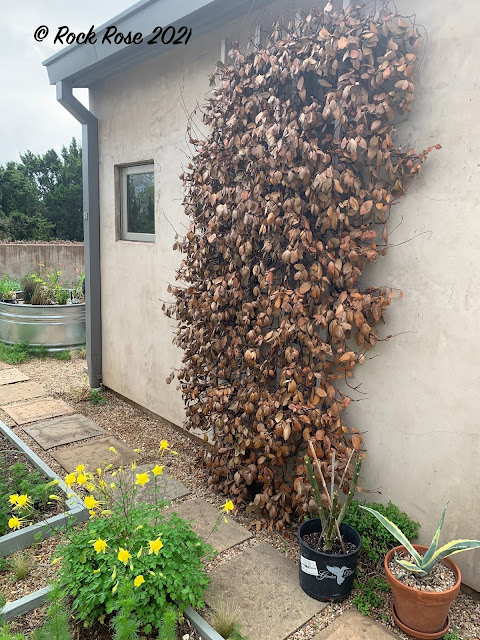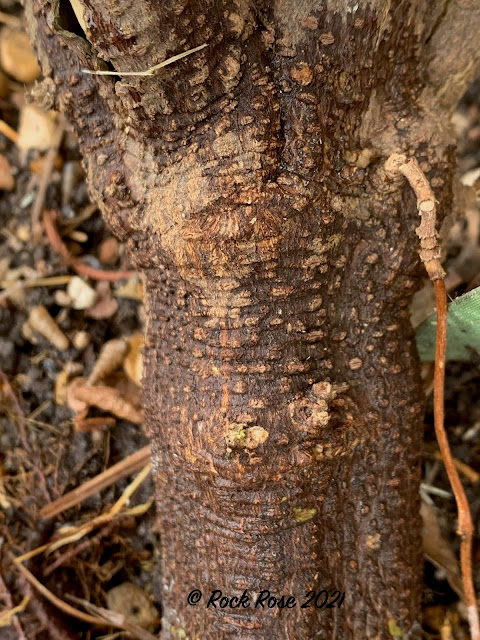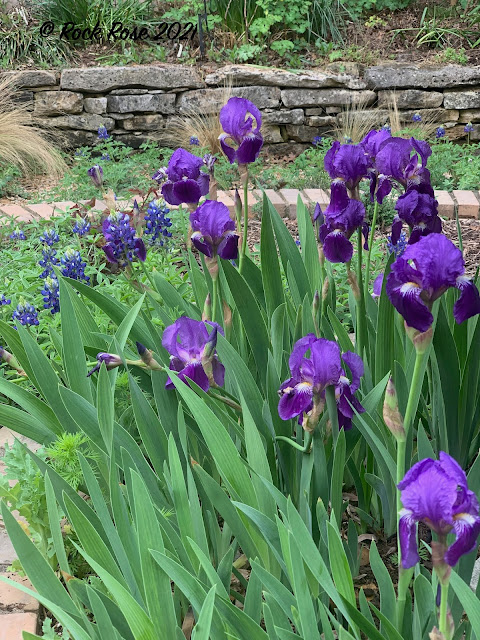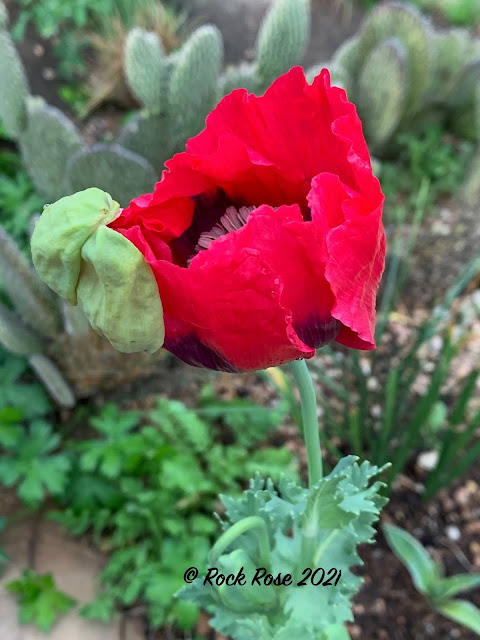To say you were browned-off was a common phrase in England when I was growing up. Maybe because my father was in the Air Force and this is where the saying is said to have originated. I think it crossed the Atlantic but if you are not familiar with it it means unhappy or displeased with a situation. Both I and many of the plants in my garden are feeling this way after our wretched deep freeze a month back.
My beautiful Texas mountain laurel grown over many years from a seed is showing no signs of life whatsoever. I fear it is doomed.
Furthermore there is an oak sapling, growing quite close to the doomed tree and now about 5' tall, which I may just allow to take the place of the Texas Mountain Laurel.
There is normally so much work to do in the spring garden and I am only just now starting to deal with some of the browned-off plants. Some I know are completely dead, others may be showing signs of life. Yesterday, I finally tackled the Confederate jasmine on the potting shed wall.
Each year a late frost will burn some of the exposed branches separating the bark from the stem. A sure sign of death. This time the same has happened throughout the plant as far down as the base so I know there is no hope of any recovery. I looked carefully at the stump and realized that it too must go. A job for the pick axe.
I decided on immediate replacement with a new Confederate jasmine and was able to find one in a 1gal. pot which is now in the ground. It is a fast grower so I know it won't be long before it is fills the trellis. The only bonus is that this year I will have less pruning to do.
 |
I'm pretty browned off about the jasmine at the front door. Similar to the Confederate jasmine but slightly hardier and with a white flower tinged with yellow, it was Trachelospermum asciaticum. It is no more.
We have made the decision, after putting the question out to gardening group about possibilities, not to replace. It will be a welcome reduction in constant pruning but we will miss the gorgeous fragrance when we walked out of the front door.
We are tackling the brown-off little by little but there is some time to admire those plants that survived the brutal and unexpected cold. The gardener quickly moves along from the losses that occur in the garden.
The crossvine, Bignonia capreolata, on the greenhouse is as spectacular as ever. But also due to be cut down to the ground this year in order to control its growth.
The purple iris around the bird bath in the English Garden.
As always, a profusion of the yellow columbine, Aquilegia chrysantha var. hinckleyana.
Where did this red poppy come from. Before I have only had large pink ones.
And the usual profusion of bluebonnets.
With the Easter weekend upon us I hope that everyone will be able to enjoy some time spent outdoors enjoying springtime blooms.
HAPPY EASTER EVERYONE









































10 comments:
I've never heard that expression but it seems entirely appropriate to the circumstances. I'm sure all that dead brown stuff is painful to look at, as well as time-consuming to remove and replace. I'm glad you at least have some pretty plants to distract you. Happy Easter Jenny.
I have never heard this expression but I can see how appropriate it is for your situation. We have had a bit of frost damage here the past couple of nights. Nothing like the destruction in your garden but disappointing none the less. All of the Easter flowers loo mushy. Your last picture here looks so cute. I hope you have a happy Easter.
As a lifelong avid reader of British fiction I have heard of the expression. The losses post storm are sad but as you said 'gardeners move on'. Events like the storm really separate the tough from the not so. Happy Easter.
"The gardener quickly moves along from the losses that occur in the garden" well said Jenny. And I am glad you are at the point where you're able to say it, I know from experience that it takes awhile.
Happily following your beautiful garden from El Paso, TX! I’m curious to know more about how you went about establishing your gardens, would you mind sharing? I’m wanting to convert my own garden to a gravel and rock garden and am curious to know if you took any steps before laying down gravel and pavers, such as amending the soil and the depth of gravel; as well as if you originally planted wildflowers and other self-sowers in the gravel or if they’ve simply seeded themselves over time?
I have learnt a lot since we started making these gardens 20 years ago. I might do things differently if I was doing it again. The ledge stones came from the foundation and form the raised beds in front and back. We are lucky to have our own 'quarry'. There is very little soil under the natural parts of the garden but the raised beds obviously had to be filled. It was mostly what we call sandy loam here with some amendment. The sunken garden had originally a layer of decomposed granite but plants seeded too freely so we laid Az.sandstone. The front garden was just the native caliche with gravel on the surface. Not even a deep layer. I had no idea I was going to start planting agave in the front courtyard and unfortunately some did not do well there because the soil was too good. I think what you put down would depend upon what you want to grow. I have mainly native plants and they don't like rich soil. If you read Beth Chatto's book she did amend her soil quite deeply before laying the gravel but she had no plan to water. of course it may be dry ion that part of England but no where near the heat we experience. It is certainly a challenge. We put in a decomposed granite pathway around the back with just the thin native soil beneath. Bluebonnets absolutely love the area as well as liatris cactus, and agave. In a normal winter we would not have lost all our A.weberii. It is very sad. If you need more you can email me your email address and I can write more easily. Good luck.
I was quite saddened to see the demise of your A. Weberii! I lost a couple of small A. Desmettiana during the freeze out here, so I know the feeling all too well. I’m also intently focusing on texas and chihuahuan desert natives, but the concept of a rock garden is still new to me. How I envy your carpets of bluebonnets! Haven’t had much luck with them but then our winters aren’t nearly as wet out here in west texas compared to central texas. Will have to simply admire from afar when I am back in Austin
I was quite saddened to see the demise of your A. Weberii! I lost a couple of small A. Desmettiana during the freeze out here, so I know the feeling all too well. I’m also intently focusing on texas and chihuahuan desert natives, but the concept of a rock garden is still new to me. How I envy your carpets of bluebonnets! Haven’t had much luck with them but then our winters aren’t nearly as wet out here in west texas compared to central texas. Will have to simply admire from afar when I am back in Austin
I was quite saddened to see the demise of your A. Weberii! I lost a couple of small A. Desmettiana during the freeze out here, so I know the feeling all too well. I’m also intently focusing on texas and chihuahuan desert natives, but the concept of a rock garden is still new to me. How I envy your carpets of bluebonnets! Haven’t had much luck with them but then our winters aren’t nearly as wet out here in west texas compared to central texas. Will have to simply admire from afar when I am back in Austin
I was quite saddened to see the demise of your A. Weberii! I lost a couple of small A. Desmettiana during the freeze out here, so I know the feeling all too well. I’m also intently focusing on texas and chihuahuan desert natives, but the concept of a rock garden is still new to me. How I envy your carpets of bluebonnets! Haven’t had much luck with them but then our winters aren’t nearly as wet out here in west texas compared to central texas. Will have to simply admire from afar when I am back in Austin
Post a Comment